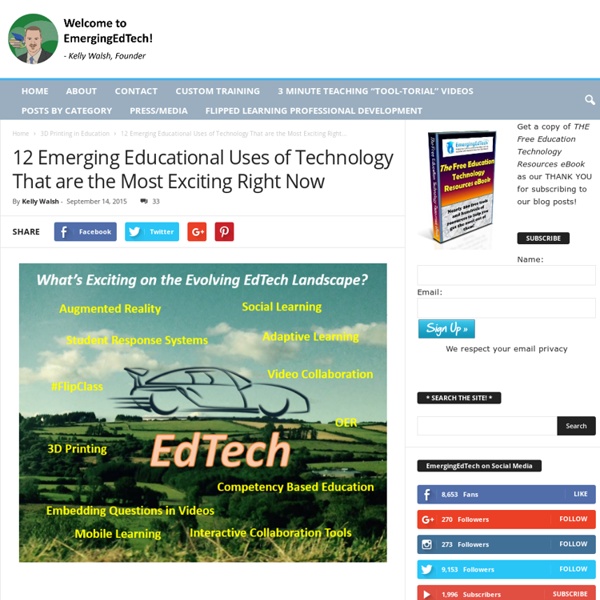Gamification And Game Based Learning: Yes, They Are Different!
Gamification and game based Learning (GBL) are both very popular trends in corporate learning now. The benefits of games are evident in training and learning; not only at the K-12 level, but in corporate circles as well. But both terms, gamification and game based Learning, cannot be used interchangeably. They’re not the same thing and it is important to realize the difference. With evolution of technology, there is continuous evolution in technology-aided learning as well. New ways of imparting continuous learning is now a priority for most organizations who realize the worth of effective learning within the workspace.
Top 22 Ways To Use Technology in the Classroom
If your state adopted the Common Core State Standards, 75% of you will administer yearly assessments online. If students haven't used online tools or software for classwork, this can be a daunting task. Having computer devices as optional education tools is much different from requiring students to use those devices for graded assessments. This can be intimidating for both students and teachers.
50 Free Animation Tools And Resources For Digital Learners
50 Animation Tools & Resources For Digital Learners by Lisa Chesser, opencolleges.edu.au A purple monster with wild curls spiraling out of control explains the economics of oil production in the Sudan to students in Los Angeles, Sydney, Berlin, Jerusalem, and Riyadh. That is education and animation working together to teach students everywhere, everything they ever wanted to know. Educators need only utilize the tools available, most of them for free. Some of the animation links catalogued here will give educators very basic tools and histories of animation while others have the animation already created and set in motion, it’s just a matter of sharing it with students.
How to Integrate Technology into your Classroom - Kognity
For this week’s blog post, we have a guest writer with years of experience in edTech – both teaching himself as well as training teachers on how to incorporate tech into their classrooms. Justin Degonda grabbed his M.Ed. from the University of Minnesota, has seven years in educational technology as an Associate Director of IT and Applications for 42 schools on the east coast of the United States and as an IT Director for a bilingual school in Central America. It does not matter if the classroom is online or in a physical space, studies show student engagement is key to great learning results! Why? Because interaction with learning material engages more than just listening or reading.
13 Simple Ways to Integrate Technology into any Lesson Plan – PowToon Blog
The pressure is on, and educators are feeling it more and more. Principals and school boards everywhere are requiring teachers to integrate technology into the classroom. Sometimes, the change is as simple as adding a computer class to the curriculum, other times it requires teachers to literally flip their entire lesson plan into a hi-tech beast! Although these flipped classrooms give students an edge, they may also give their teachers a headache! Don’t worry, I’m here to show you that whether you teach 2nd-grade math or high school biology there is a simple way to ‘techify’ your existing lesson plans.
Seven Ways to Recycle eLearning Video Content by John Parsons
Using interactive video for eLearning and mLearning is an exciting, thought-provoking trend. Moving beyond our preconceived notions about video, namely that it’s too boring and/or costly, is a potential game changer. Creating, recycling, and combining smaller “chunks” of content could potentially solve some important problems for developers.
What Is Successful Technology Integration?
Technology integration is the use of technology resources -- computers, mobile devices like smartphones and tablets, digital cameras, social media platforms and networks, software applications, the Internet, etc. -- in daily classroom practices, and in the management of a school. Successful technology integration is achieved when the use of technology is: Routine and transparent Accessible and readily available for the task at hand Supporting the curricular goals, and helping the students to effectively reach their goals
A TPACK-based Approach for An Effective Integration of Technology in Your Teaching
August 11, 2015 Technology is definitely a game changer in today’s classroom. Its pervasive widespread in educational settings speaks volumes about the growing importance we come to place in it. However, while many teachers have already domesticated some of this technology into their daily workflow (e.g, preparing handouts and docs, creating lesson plans, communicating with students and parents…etc) a pragmatic leverage of this technology for instructional purposes remains barely noticeable. By pragmatic leverage we mean the use of technology to enhance key cognitive skills such as higher order thinking skills, critical thinking skills, and problem solving to mention a few.Technology integration in this sense is not an end in and by itself by a means, a roadmap to facilitate teaching and learning. Working towards a student-centerer pedagogy where technology is used effectively to create optimal learning experiences for students mandates careful planning and strategic execution.
DocStickers: A Docs + Keep Integration for Old School feedback
Today, I'm excited to tell you about DocStickers! If you can give me 90 seconds of your time, this video is worth a watch! Otherwise, continue below. I remember getting papers back with stickers and stamps as a kid. While I may not remember the specific assignments and what I learned from them, but I remember how it made me feel when I saw a sticker or stamp on them. While my teachers were just taking stickers from a page and adhering them to all of the student papers, it meant something because they took them time to do it.



